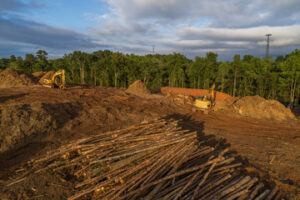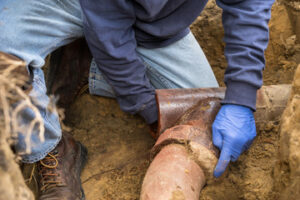Land Clearing Belton TX involves removing vegetation, debris, and stumps from an area to make it more accessible for construction or farming. This can be done by hand or using mechanical methods such as bulldozers and backhoes.

Overgrown areas can create shade that causes water to pool during rainy periods, attracting mosquitoes and other pests. Rotting trees can also attract termites and rodents.
Overgrown trees, weeds, and shrubbery can easily cause soil erosion, especially when they are located in wet areas like ponds and streams. During the rainy season, they can wash away soil and carry it downstream, where it may damage structures and disrupt ecosystems. Performing land clearing removes these obstacles, which reduces the risk of soil erosion and makes it easier for new vegetation to grow in the area.
Land Clearing is an essential step in the agricultural process as it helps boost crop productivity. Overgrown weeds, trees, and grass can block sunlight from reaching the crops, which prevents them from getting the nutrients they need to thrive. By clearing the land, you can expose more of the soil to sunlight and promote healthy plant growth. Moreover, it also helps control pests and prevent soil erosion.
Aside from soil erosion, overgrown weeds and rotting trees can become fire hazards during the summer months. This can pose a serious threat to the safety of you, your family, and passersby. Hence, it is important to perform Land Clearing regularly.
When you clear land, you’re removing the binding roots that keep the soil in place. Without these root systems, the soil can easily be washed away, which threatens future plant growth and jeopardizes the integrity of waterways and nearby buildings. Land clearing professionals use specialized machinery to ensure that the soil is cleared properly, preventing erosion and ensuring that the land is suitable for agriculture or construction.
The land clearing process also includes tearing down and hauling away any existing structures like sheds or stables, as well as digging out and removing concrete foundations. This can be a time-consuming task, so it’s best to hire a professional to do the job for you. Once all the debris and unwanted plants have been removed, the land is then graded to create a smooth surface that’s ready for construction or farming. Lastly, the land is inspected to make sure that it meets all requirements and standards, such as proper debris disposal and grading, before it’s deemed ready for its intended purpose.
Prevents Pests
Dense brush and piles of leaves offer ideal breeding grounds for pests, allowing them to thrive without being discovered. As they move from these natural habitats to residential properties, rodents and insects can pose health risks and damage structures like homes and cars. Land clearing allows for a more controlled and manageable landscape that makes it harder for pests to enter and remain on the property.
Selective clearing involves carefully examining the site and differentiating invasive species from native plants and animals that would thrive in the area. Invasive plant species are often foreign to local ecosystems, and they can wreak havoc by spreading quickly without natural predators. By removing these species, land clearing services can help preserve biodiversity in the area and prevent pest infestations in residential areas.
The removal of overgrowth also helps the remaining plants, trees, and bushes flourish by giving them the space they need to grow and mature. It is difficult for plants to thrive when they are crowded together, limiting their access to water, nutrients, and sunlight. Land clearing removes a variety of overgrowth and other dead vegetation, ensuring that the remaining plant life gets all the resources it needs to thrive.
In addition, land clearing also reduces the risk of fires on properties. Fires are more likely to occur in areas that are overgrown with dense vegetation and have a buildup of dry twigs and leaves. This is particularly true when a plot of land has been left to become overgrown and neglected.
A well-maintained landscape that is regularly cleared of weeds, bushes, and other overgrowth can help prevent termite and carpenter ant infestations. These pests are known to feed on the wood that forms structural components of buildings, which can cause significant damage if not treated. These pests are often displaced from their natural habitats by wildfires or other environmental disturbances and seek refuge in the woody and overgrown areas near residential properties. Land clearing can eliminate these habitats and prevent pests from moving to the home, reducing the need for chemical pest control methods and promoting a safer and healthier environment.
Increases Property Value
If your property is cluttered with dead branches, shrubs, and trees, it can detract from its aesthetic value. Land clearing removes these hazards, leaving a beautiful, open space that attracts buyers and increases its value.
In addition to enhancing the look of your property, clear land also protects it from fire and other environmental hazards. It’s important to choose a land clearing company that uses environmentally conscious techniques. This will ensure that the clearing process does not disrupt local ecosystems and helps promote healthy growth of new vegetation.
Many investors and homeowners are willing to pay a premium for a plot of land that is clear and ready for development or landscaping. It’s difficult for them to visualize how they would use the space if it is covered in bushes and trees, but a clean, cleared plot makes it much easier to see potential.
Clearing can increase your property value by making it more attractive to buyers and increasing its utility. If you plan to sell your property in the future, it’s important to keep it clear so that you can attract investors and homebuyers.
Whether you have a large lot or a small parcel, the appearance of your property is a critical factor in its value. It’s the first thing that potential buyers will notice, so it’s important to make sure your yard is free of debris and other unsightly elements. Land clearing can help you achieve this goal by removing invasive weeds, dead trees, and other unwanted plants.
Aside from improving the visual appeal of your property, land clearing can help you save on maintenance costs. Overgrown plants and trees require a lot of care, including trimming, watering, and fertilizing. By hiring a professional land clearing service, you can reduce the amount of work that is required to maintain your property.
Another way that land clearing can boost your property value is by preventing soil erosion. Overgrown trees and shrubs are at a higher risk of losing their topsoil, especially in windy areas. This is because they tend to lose moisture through their leaves, and wind can carry away the loose topsoil. By clearing your land, you can prevent soil erosion and make it easier for plants to retain their moisture.
Prevents Soil Damage
Land Clearing helps prevent soil damage, as it removes dead or overgrown vegetation that competes with plants for water, sunlight, and nutrients. It also improves the overall health of the land, by allowing it to cultivate healthy levels of soil nutrients and encouraging the growth of native plants that are better suited to the local flora and climatic conditions. In addition, clearing allows the topsoil to be redistributed evenly, which reduces weed growth and soil erosion.
Another benefit of Land Clearing is that it can help prevent pests and other hazards, such as tripping or falling branches or tree stumps, from posing risks to people and equipment on the property. It also ensures that there is enough room for vehicles and machinery to move around the site without damaging it or causing safety risks.
Lastly, clearing can help prevent the spread of diseases to wildlife and people by eliminating potential breeding grounds for pests. For example, rotting trees and overgrown vegetation can harbor viruses that can be spread by mosquitos or rodents. By removing these potential breeding grounds, clearing can prevent the spread of airborne diseases like malaria, hepatitis C, and influenza.
In some cases, the vegetation removed during land clearing can be used as mulch to improve the health of the surrounding soil. Mulch adds extra nutrients to the soil, which can promote healthy plant growth and prevent weeds from growing. It can also help reduce the amount of dirt that runs off the property during rainy periods, preventing pollution in nearby lakes, rivers, and streams.
In some cases, the use of land clearing can also be used to protect valuable habitats for wildlife by establishing buffer zones along water bodies that may be impacted by land development activities. In these instances, selective clearing involves only removing specific species of vegetation from an area rather than the entire landscape. This method can be more sustainable and help maintain biodiversity. Additionally, it can help preserve water quality and provide safer drinking water for communities downstream. In these cases, it is important to work with experienced professionals who are knowledgeable of these types of environmental concerns.


